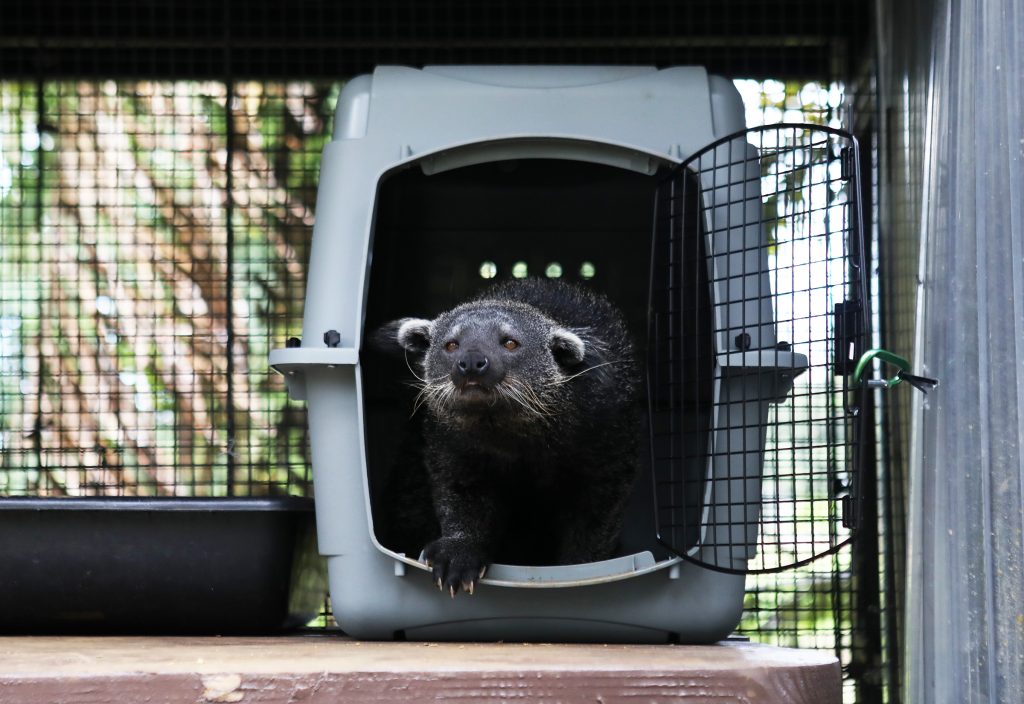Panaʻewa Rainforest Zoo has a new adorable resident to woo a 16-year-old binturong
At Panaʻewa Rainforest Zoo and Gardens, 16-year-old female binturong Keoki-Anne now has a male companion.

Born at the Belgrade Zoo in Serbia, Chandler “Bing”turong traveled a long way to find his new home at the Hilo zoo.
Chandler was named after the character of the TV show ‘Friends,’ which was one of the options in a vote on social media. He has been at the zoo since July of last year, but was introduced to the public last weekend since it took time for zookeepers to facilitate cohabitation introductions between Chandler and Keoki-Anne and work on the renovating the binturong exhibit.
“We took a long time introducing them to make sure they did get to know each other before we put them together,” said zoo administrator Mindy Runnells. “We had them in side by side enclosures and slowly opened the adjoining door.”
The two are vocal with each other, and do have some spats. But Runnells said they are good at working things out.
“They have so much space out here that they can get away from each other if needed,” she said.
The binturong, also known as the bearcat, is native to South and Southeast Asia and is declining in population due to habitat loss from deforestation. It has been assessed as vulnerable on the International Union for Conservation of Nature Red List of Threatened Species.
Binturongs are common in zoos, and captive individuals are often offspring of several generations of captive-bred animals, which is the case for Keoki-Anne and Chandler. They represent a source of genetic diversity essential for long-term conservation.

The process of acquiring a new animal for the zoo can be a long one, especially from a different country, Runnells said.
In Hawaiʻi, the zoo must start by applying for an import permit with the State Department of Agriculture, but since Panaʻewa has already brought in and housed binturongs, that was the easy part.
The zoo then had to wait for letters of acceptance from the state veterinarian and the federal government. There also was a lot of paperwork for the Serbian zoo and the government since Europe is also very strict about wild animal export and import.
Binturongs can carry rabies, so Chandler went through a series of vaccines and testing before leaving Serbia for his long journey to his new home.
“Chandler was then packed in his approved transport crate and sent halfway around the world making a few stops in Europe and Asia before making it to Hawai’i,” Runnells said. “He was inspected in Honolulu and here in Hilo before coming to the zoo.”
She added: “He was a great traveler! He was hardly even dirty when he got here.”

After arrival, animals typically spend 30 days in quarantine with a couple of vet exams and three fecal tests. Some reptiles need a 90-day quarantine, but the amount of time is species dependent.
The health of an animal also plays a part. Zookeepers give them a calm and quiet time to let them adjust to the new environment. They prepare meals with varying items to see what the favorites are, which makes training much easier.
“Bananas were the clear winner,” Runnells said. “We joked that we should have learned some Serbian as he must have been so confused by our words.”
The zoo keepers also made a lot of enrichment items and climbing structures for Chandler, and planned activities to encourage his natural exploring curiosity.

During the weekend, the Panaʻewa Rainforest Zoo opened the new binturong exhibit after months of renovations to the habitat. Chandler was able to make his grand first appearance while Keoki-Anne celebrated her sweet 16th birthday with special treats and decorations.
Zoo crew have been rearranging exhibits and renovating habitats to give animals a more dynamic space and to give zoo visitors a better view of the animals. The binturongs and the lemurs are neighbors in this new habitat, which is full of features to support natural behaviors.
“Our crew and volunteers put up new mesh and painted the outside, and the zookeepers built all new ‘furniture’ and sunning platforms, repurposed firehose to create climbing structures, planted new plants and installed all of the tree perches,” Runnells said.
These all keep the animals engaged and entertained.

The next renovations will be done around the South American exhibit next to the playground. New mesh will be put on four more aviaries for better viewing and crews have started the demolition of the site for the newest construction project – a habitat for the Colobus monkeys.
After a successful first year, spots are quickly filling for the zoo’s next event, “Snooze at the Zoo,” which is a fun sleepover event March 18-19 for keiki 9 to 10 years old during spring break.
The Panaʻewa Rainforest Zoo and Gardens and the County of Hawaiʻi Department of Parks and Recreation Division of Recreation are partnering for the event, which costs $50 and includes dinner Tuesday night, breakfast, lunch, snacks and a t-shirt.
For more information, or to sign-up, call 808-961-8681. A parent/guardian meeting is mandatory and will be at 6 p.m. this Wednesday at Aunt Sally Kaleohano’s Lū‘au Hale in Hilo.
Sponsored Content
Comments








